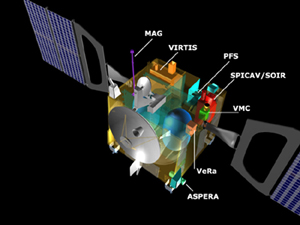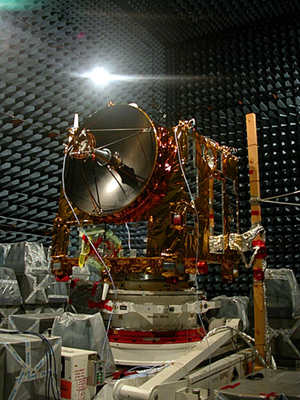
"Analyzer of Space Plasmas and Energetic Atoms," This instrument will investigate the interaction between the solar wind and the Venusian atmosphere, determine the impact of plasma processes on the atmosphere, global distribution of plasma and neutral gas, and analyze other aspects of the near Venus environment. ASPERA-4 is a re-use of the ASPERA-3 design used on Mars Express, but adapted for the more energetic environment near-Venus.
See pictures of the ASPERA-4 instrument on the IRF at the Sweedish Institute of Space Science.
This magnetometer will measure the strength of Venus's magnetic field and the direction of it as affected by the solar wind and Venus itself. It will also aid ASPERA-4 in the study of the interaction of the solar wind with the atmosphere of Venus. MAG is derived from the Rosetta lander's ROMAP instrument.
The "Planetary Fourier Spectrometer" operates in the infrared between the 0.9 µm and 45 µm wavelength range and is designed to perform vertical optical sounding of the Venus atmosphere. It will perform global, long-term monitoring of the three-dimensional temperature field in the lower atmosphere (cloud level up to 100 kilometers). It will also search for minor atmospheric constituents that may be present, analyze atmospheric aerosols, and investigate surface to atmosphere exchange processes. The design is based on a spectrometer on Mars Express, but modified for optimal performance for the Venus Express mission.
Go to the official Venus Express PFS webpage.
Short for "Spectroscopy for Investigation of Characteristics of the Atmosphere of Venus", SPICAV is an imaging spectrometer that will be used for analyzing radiation in the infrared and ultraviolet wavelengths. In particular, it will search for the small quantities of water expected to exist in the Venusian atmosphere. It will also look for sulphur compounds and molecular oxygen in the atmosphere. It will determine the density and temperature of the atmosphere at 80–180 kilometres altitude. It is derived from the SPICAM instrument flown on Mars Express. However, SPICAV has an additional channel known as SOIR (Solar Occultation at Infrared) that will be used to observe the Sun through Venus's atmosphere in the infrared in the occultation experiments planned.
More information (in French only) here. Pictures can be found here
The Venus Radio Science is a radio sounding experiment that will transmit radio waves from the spacecraft and pass them through the atmosphere or reflect them off the surface. These radio waves will be received by a ground station on Earth for analysis of the ionosphere, atmosphere and surface of Venus. Scientists will also use it to study the density, temperature, and pressure of the atmosphere from 35–40 km up to 100 km from the surface, and to determine roughness and electrical properties of the surface. It will also allow investigations of the conditions of the solar wind in the inner part of the Solar System. It is derived from the Radio Science Investigation instrument flown on Rosetta.
VIRTIS (Visible and Infrared Thermal Imaging Spectrometer) is an imaging spectrometer that observes in the near-ultraviolet, visible, and infrared parts of the electromagnetic spectrum. It will analyze all layers of the atmosphere, surface temperature and surface/atmosphere interaction phenomena. It will obtain point spectra and track the clouds in both ultraviolet and infrared wavelengths in the day and night side and will allow scientists to study atmospheric dynamics at different altitudes.
More information at the VIRTIS for Venus Express webpage.
The Venus Monitoring Camera is a wide-angle, multi-channel CCD. It will be able to make global images and will study the cloud dynamics and image the surface. It will also assist in the identification of phenomena seen by other instruments. VMC will operate in the visible, ultraviolet, and near infrared spectral ranges. It will map surface brightness distribution and search for volcanic activity, monitor airglow, study distribution of unknown ultraviolet absorbing phenomenon at the cloud-tops, and other science observations. It will create images and movies as well. It is a new instrument derived only in part by the Mars Express High Resolution Stereo Camera (HRSC) and the Rosetta Optical, Spectroscopic and Infrared Remote Imaging System (OSIRIS).
More information at the VMC for Venus Express webpage at the Max Planck Institute for Solar System Research.
